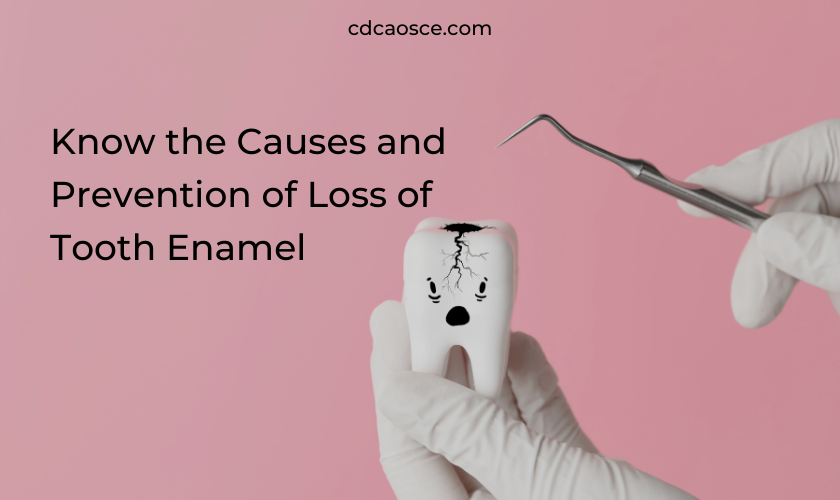Introduction
“Smile, it’s the key that fits the lock on everyone’s hearts. And teeth are the tools that make it happen.” – Anthony T. Hincks
Without teeth you may have a conscious smile. They help you chew, speak, and smile with confidence. Loss of tooth enamel is one of the leading dental problem common these days. More on the loss of tooth enamel including treatment and ways to prevent it.
What is tooth enamel?
Tooth enamel is the hard, outer layer of your teeth that protects them from damage. It is the hardest substance in your body, even stronger than your bones. Tooth enamel also helps to maintain the shape and structure of your teeth, as well as giving them their color.
What causes loss of tooth enamel?
Some known reasons below
- Acidic Foods and Drinks: Consuming foods and drinks that are high in acid, such as soda, citrus fruits, and vinegar, can erode the enamel on your teeth over time.
- Dry Mouth: Saliva helps to neutralize the acids in your mouth and prevent them from damaging your teeth. If you suffer from dry mouth, your teeth may be more susceptible to enamel loss.
- Brushing Too Hard: Brushing your teeth too hard or using a toothbrush with hard bristles can cause the enamel on your teeth to wear away.
- Bruxism: Grinding your teeth or clenching your jaw can cause the enamel on your teeth to wear away.
- Acid Reflux: Acid reflux can cause stomach acid to enter your mouth, which can erode your tooth enamel over time.
- Genetics: Some people are more prone to enamel loss due to genetic factors.
- Tooth Gems: If tooth gems are not professionally applied then you may loss some of enamel upon removal. To mitigate risk its better to spend some money and get it applied by dental professional
How to prevent loss of tooth enamel?
Fortunately, there are several steps you can take to prevent this:
- Avoid Acidic Foods and Drinks: Limit your consumption of acidic foods and drinks, or consume them with a meal to help neutralize the acid.
- Use Fluoride Toothpaste: Fluoride helps to strengthen your tooth enamel and protect it from damage.
- Brush and Floss Regularly: Brush your teeth twice a day and floss at least once a day to remove plaque and bacteria from your teeth.
- Use a Soft-Bristled Toothbrush: Use a toothbrush with soft bristles to avoid damaging your tooth enamel.
- Drink Plenty of Water: Drinking water helps to rinse away the acids in your mouth and keep your teeth clean.
- Chew Sugar-Free Gum: Chewing sugar-free gum can help to increase the production of saliva in your mouth, which can neutralize the acids and protect your tooth enamel.
Treatment options
If you have already experienced loss of tooth enamel, there are several treatment options available:
- Dental Bonding: Dental bonding involves applying a tooth-colored resin to your teeth to repair damage and protect your tooth enamel.
- Dental Crowns: Dental crowns are custom-made caps that are placed over your damaged teeth to protect them and restore their appearance.
- Dental Veneers: Dental veneers are thin, custom-made shells that are placed over the front of your teeth to improve their appearance and protect your tooth enamel.
- Root Canal: In severe cases of tooth decay, a root canal may be necessary to remove the damaged tissue and protect the remaining tooth enamel.
FAQ’s
- Q: Can using a hard-bristled toothbrush cause enamel loss?
Yes, using a hard-bristled toothbrush can contribute to enamel loss as it can wear away the protective layer of enamel on your teeth. Dentists recommended to use a soft-bristled toothbrush and brush gently to avoid damaging your enamel. - Q: Can loss of tooth enamel be reversed?
While it is not possible to reverse the loss of tooth enamel, it can be prevented from getting worse by following tips given above - Q: Are there any foods that can help to strengthen tooth enamel?
Yes, foods high in calcium and phosphorus, such as dairy products, leafy greens, and nuts, can help to strengthen tooth enamel. - Q: How can I tell if I have enamel loss?
Enamel loss can cause a variety of symptoms, including sensitivity to hot or cold temperatures, discoloration, and rough or jagged edges on your teeth, Let your dentist know if you any of these symptoms - Q: Can enamel loss be reversed?
Enamel loss cannot be reversed, but it can be treated with dental procedures such as bonding, veneers, or crowns to restore the appearance and function of your teeth. - Q: Is it possible to prevent further enamel loss once it has occurred?
Yes, by taking preventative measures such as using fluoride toothpaste, limiting acidic foods and drinks, and maintaining good oral hygiene, it is possible to prevent further enamel loss and protect the remaining enamel on your teeth. - Q: How often should I brush and floss my teeth?
It is recommended to brush your teeth twice a day and floss at least once a day to maintain good oral hygiene. - Q: Is teeth grinding a common cause of loss of tooth enamel?
Yes, teeth grinding or bruxism can contribute to the loss of tooth enamel over time.



